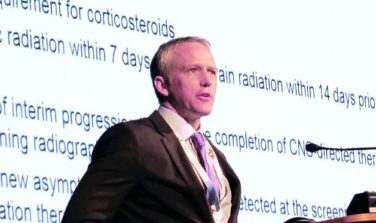EXPERT ANALYSIS FROM THE CARDIOVASCULAR CONFERENCE AT SNOWMASS
SNOWMASS, COLO. (FRONTLINE MEDICAL NEWS) – Aging men who engage in high-intensity/high-volume aerobic exercise have a greater risk of atrial fibrillation, N. A. Mark Estes III, MD, said at the Annual Cardiovascular Conference at Snowmass.
“I see a very large number of former collegiate or professional athletes who come to me in their 40s, 50s, and 60s having recently developed A-fib. These are mainly men who’ve been doing high-intensity endurance exercise,” said Dr. Estes, professor of medicine and director of the New England Cardiac Arrhythmia Center at Tufts University in Boston.
Thirty-day event monitors in these men typically show a pattern of very rapid, symptomatic atrial fibrillation (AF) arising at peak exercise or, even more commonly, immediately afterwards.
This is an aspect of the athletic heart syndrome that has gone understudied and underappreciated, according to Dr. Estes , who asserted, “The best available evidence suggests that exercise, if excessive, is probably harmful. I know that’s heresy.”
He is coauthor of a forthcoming review on this topic to be published in the Journal of the American College of Cardiology – Electrophysiology. In it, he and his coauthors analyzed more than a half dozen published observational epidemiologic studies and concluded that the collective data show a classic J-shaped curve describes the relationship between physical activity level and risk of developing AF, but only in men. The risk is roughly 25% lower in men who regularly engage in moderate physical activity as defined in American Heart Association/American College of Cardiology guidelines, compared with that of sedentary men. But the AF risk shoots up dramatically in men who focus on intense exercise.
“As you get into the high-intensity/high-endurance end of the spectrum – typically more than 5 hours per week at greater than 80% of peak heart rate – the risk of A-fib increases up to 10-fold,” according to Dr. Estes.
“These are new data. They are important data. I think these data should impact the way we counsel people about exercise, particularly men who like to get into that high-intensity/high-endurance range,” the cardiologist continued.
This J-curve doesn’t apply to women, for reasons unclear. The analysis by Dr. Estes and his colleagues documented that women who engage in moderate physical activity have a lower risk of developing AF than do sedentary women, but unlike in men, the AF risk is lower still in women who favor high-intensity exercise.
“Maybe the explanation is in part endocrinologic differences, maybe in part due to women having smaller left atria and therefore less left atrial wall stress, less fibrosis. We really don’t know, but I think the observation, based on epidemiologic data, is valid,” he said.
Proposed multifactorial mechanisms for the increased incidence of AF in aging endurance athletes hinge in part upon basic science studies. These mechanisms include atrial inflammation and fibrosis, atrial enlargement, increased vagal tone, sympathetic nervous system stimulation, pulmonary vein triggers, genetic predisposition, and use of performance-enhancing substances.
Dr. Estes’ presentation struck a responsive chord with the audience. Numerous cardiologists rose to chime in that they, too, have encountered new-onset AF in middle-aged patients, friends, and medical colleagues who are serious cyclists, marathoners, and devotees of other forms of high-intensity endurance exercise to the tune of 10-20 hours per weekly.
“I know an electrophysiologist in his 60s who probably does 20 hours per week of spin and Cross-Fit classes and who is just now going into A-fib. How should I counsel him about this?” one audience member asked.
“You can’t tell these people to stop exercising,” Dr. Estes replied. “It’s so much a part of their identity. Their endorphin levels go down, and they feel depressed.”
For these patients he stresses what he called “the virtue of moderation.”
“If they have clinically important symptoms, many times we’ll decondition them. Often their symptoms will improve, and, in some instances, the A-fib will actually clear up and we don’t even need to go to any medical therapy,” Dr. Estes said.
His exercise prescription for deconditioning such patients is “basically nothing more than a moderate jog, a 10-minute mile. They should be able to carry on a conversation, with a peak heart rate no more than 60% of their maximum.”
If drug therapy is required, he favors rate control with beta blockers, as these patients generally don’t tolerate antiarrhythmic agents very well.
“Our threshold for AF ablation in these people is quite low because the response rate is high in paroxysmal AF in the absence of underlying structural heart disease,” he added.
Dr. Robert A. Vogel, who has been a consultant to the National Football League for a decade, commented, “I agree that you can exercise too much. These are the super-elite triathletes and so forth. A few of these folks not only get A-fib, but we’ve shown they can get accelerated atherosclerosis due to pervasive endothelial dysfunction caused by excessive athletics.”
“However, nothing here should be construed as saying exercise is bad for you. Athletes, even drug-taking cyclists and football players, actually live longer than similar nonathletes,” said Dr. Vogel, a cardiologist at the University of Colorado, Denver.
Dr. Estes was quick to agree.
“The cardiovascular benefits of exercise resoundingly overwhelm the adverse effects in that small group that experiences adverse effects,” he said.
Dr. Estes reported serving as a consultant to Boston Scientific, Medtronic, and St. Jude Medical.



